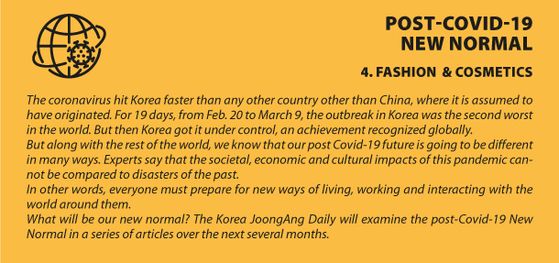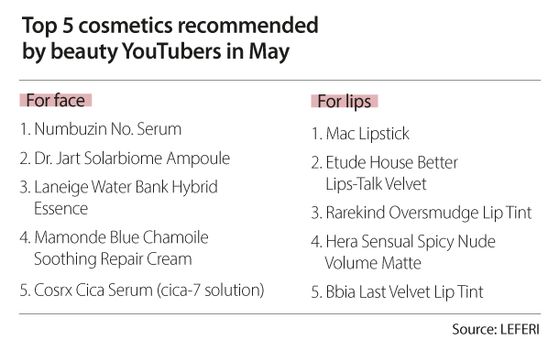[Post-Covid-19 New Normal] Social distancing in style - how masks have become the new 'it' accessory
![Photo of Japanese model Kozue Akimoto participating in 2020 Paris Fashion Week wearing a mask designed by Marine Serre. [SCREEN CAPTURE]](https://koreajoongangdaily.joins.com/data/photo/2020/07/01/32a35c3f-99ec-4f26-94e8-5d4b54e1c1e5.jpg)
Photo of Japanese model Kozue Akimoto participating in 2020 Paris Fashion Week wearing a mask designed by Marine Serre. [SCREEN CAPTURE]

Did a young French fashion designer predict the coronavirus pandemic?
Not exactly, but she was well ahead of the game when it came to predicting the biggest fashion trend of the year so far — masks.
During Paris Fashion Week in February, Marine Serre introduced anti-pollution masks for fall/winter 2019 through a collaboration with French filtration brand R-PUR. Little did Serre know that she'd hit the jackpot.
The following year, a photo of Japanese model Kozue Akimoto attending fashion week wearing one of Serre's masks went viral online.
Long before the coronavirus pandemic took its toll on the world and masks became an essential part of every day fashion, Serre’s runway debut in 2018 Paris Fashion week featured models wearing tough jackets, head wraps, scarfs and gigantic sunglasses that acted as a “shield” for their wearers.
“You want to hide a little bit,” the designer told The New York Times after her debut show. “That’s the world today.”
Her words ring even truer today and it seems like the era when fashion must not only be functional but also protective is upon us.
Are masks here to stay?
![Before the coronavirus pandemic, no one would have predicted that masks will become a part of the fashion industry. [SCREEN CAPTURE]](https://koreajoongangdaily.joins.com/data/photo/2020/07/01/f491c092-e7d9-4162-aa95-8f9b11d0bd14.jpg)
Before the coronavirus pandemic, no one would have predicted that masks will become a part of the fashion industry. [SCREEN CAPTURE]
Before wearing masks on public transport became mandatory in Korea, the cloth versions of the face covering were trending in the country.
During the early 1990s when Lee Ju-no, a member of the mega-influential boy band Seo Taiji and Boys, began wearing a mask as a fashion-statement, his teenage fans followed suit.
“Boys were wearing these black masks all the time even when the weather wasn’t cold and there was no fine dust,” according to fashion YouTuber Choi Hui-seung. “[Wearing masks] represented the rebellious and were thought to have created a dark atmosphere,” she said on a video on her channel.
“But masks [were] initially derived from the western hip-hop and thug culture in the black community,” Hosup Kan, creative director and professor at Hongik University said. “To cover up their faces from CCTV cameras when they were committing crimes, that’s how the wearing of masks started in the West, which followed into hip hop. Considering how it started, negativity concerning masks still persists [in the West.]”
In a JoongAng Ilbo interview last month, fashion designer Park Youn-hee mentioned that in order to buy masks in Paris, you needed a doctor’s prescription, a clear indicator of just how differently mask-wearing is seen in different countries.
“I was in Paris in March when comedian Kim Sook called me to ask me if I could get some masks here because Korea was facing a shortage,” Park said. “So I went to the pharmacy, but the pharmacist asked me for a medical prescription to buy the masks because only sick people wear masks in that region. If I started wearing masks on the streets, people would look at me strangely and there’s also a risk of me being harmed.”
Which is why professor Kan still remains dubious that fashion masks will ever become trendy again outside of Korea once the pandemic subsides.
“People have just started to wear masks because it is the most effective way to prevent the spread of the outbreak, but regions in northern Europe are still unfamiliar with the norm. It is definitely going to stick around in Korea and other parts of the world where there’s fine dust and pollution,” he said. “Like other fashion accessories such as hats and gloves, masks will also be out on display at stores for people to choose according to their tastes.”
Behind the masks
While KF94 masks are to have been proven effective in offering the best of protection from the coronavirus by filtering 94 percent of particles that measure 0.4-micrometer, the constant wearing of the face coverings have had an unwanted side effect for many. Due to the lack of ventilation, people are seeing their skin suffer from outbreaks of pimples or rashes in the areas covered by the masks.
A more trivial issue has also arisen for make-up wearers, especially as the weather has gotten warmer, who find their foundation and lip products are either rubbed off or smeared.
The cosmetic industry has responded with the adoption of the key words such as "soothing” and “mattifying.”
![Beauty YouTubers are coming up with ways to make sure the make-up isn't smudged onto the masks. [SCREEN CAPTURE]](https://koreajoongangdaily.joins.com/data/photo/2020/07/01/f24c4110-2fcb-4733-939a-386a471d0323.jpg)
Beauty YouTubers are coming up with ways to make sure the make-up isn't smudged onto the masks. [SCREEN CAPTURE]
According to a monthly data report presented by Leferi, a data processing company for cosmetics, the top five recommended facial care products by fashion YouTubers from April to May changed drastically compared to previous time periods. (For May, the report was based on the recommendations of 473 YouTubers and 1,338 video clips.)
“The current top five skin products were all beneath the top 10 ranks before the coronavirus,” an insider who wished to remain anonymous told the Korea JoongAng Daily. “Now, the list of popular lip products is dominated by matte products which won’t stain the masks, and eye makeup that emphasizes your features — particularly eye shadow — has became more popular as they are the only visible part of the face when wearing a mask.
“As long as masks are part of our lives, these products will continue to be popular in cosmetics,” she added.

Social distancing in style
Another trend that is seeing renewed popularity is what's being dubbed as “one-mile wear.”
Most people observing social distancing are limiting their movements, often to within walking distance of their homes to also avoid public transport.
“Even if they do go out for a bit of exercise or dining out, they don’t go far,” professor Kan noted. “A lot of companies have ordered their employees to work from their homes, and you don’t want to wear your normal formal work wear at home."
![Called "one-mile wear," social distancing has led to trending of casual clothes that could be worn comfortably both in homes and outdoors. [VOGUE]](https://koreajoongangdaily.joins.com/data/photo/2020/07/01/baec66a0-d930-4870-b342-1f28b5982ee3.jpg)
Called "one-mile wear," social distancing has led to trending of casual clothes that could be worn comfortably both in homes and outdoors. [VOGUE]
People are taking advantage of being able to ditch their suits and pencil skirts and enjoying more casual and comfortable lounge wear options, such as hoodies, shorts, and leggings which are also appropriate enough to be worn outside if you should choose to venture out for some errands.
“You want to be comfortable, but not too shabby because [wearing your home clothes all the time] can make people feel like they’re falling behind,” Kan said. “For instance when you’re holding online meetings, you want to at least look presentable.”
Local fashion houses are also using this period when many are stuck at home to release "resort looks.” Despite being unable to travel outside the country, many hope they will still have a chance to take a 'socially distant' break. In line with people’s determination, Samsung C&T Fashion group’s Kuho, for instance, released a series of “resort looks” inspired from nature — big, leafy prints and bright pastel colors — with hopes that by wearing them, people can enjoy their vacations within the country.
Doing their part
In a time when hundreds of thousands of people across the globe are losing their lives, loved ones and livelihoods, what's trending in the fashion world seems like a particularly frivolous concern.
However, fashion brands are showing that they have much more to offer than clothes, shoes and accessories, and have taken a stand.
Some of the fashion world's biggest names have halted the production of their products and instead are manufacturing face masks, hand sanitizer and protective suits to donate to those in need.
![Luxury brand Bvlgari donates millions of masks and sanitizing hand gels regularly to regions in need, including France, Italy, Spain and China. [SCREEN CAPTURE]](https://koreajoongangdaily.joins.com/data/photo/2020/07/01/2cf5a7be-1cdd-4e54-8091-b6a5a981beb4.jpg)
Luxury brand Bvlgari donates millions of masks and sanitizing hand gels regularly to regions in need, including France, Italy, Spain and China. [SCREEN CAPTURE]
For instance, Prada is reported to have produced and donated 110,000 masks to healthcare workers in Tuscany, Italy in March while Gucci, Yves Saint Laurent and Balenciaga are just a few of the many designer brands who have announced that they will be donating millions of masks to areas in dire need.
High-street brands such as Zara and Mango are also following suit.
Professor Kan predicts that the need for sanitary items will persist.
“It’s highly likely that demands for sustainable fashion will surge due to consumers who wish to escape from the environmentally-polluted and virus-stricken world,” Kan said. “Brands will continue to work towards developing the sustainability of the masks for environmentally-cautious consumers who are growing concerned about the amount of disposable masks accumulating in garbage.”
BY LEE JAE-LIM [lee.jaelim@joongang.co.kr]










with the Korea JoongAng Daily
To write comments, please log in to one of the accounts.
Standards Board Policy (0/250자)